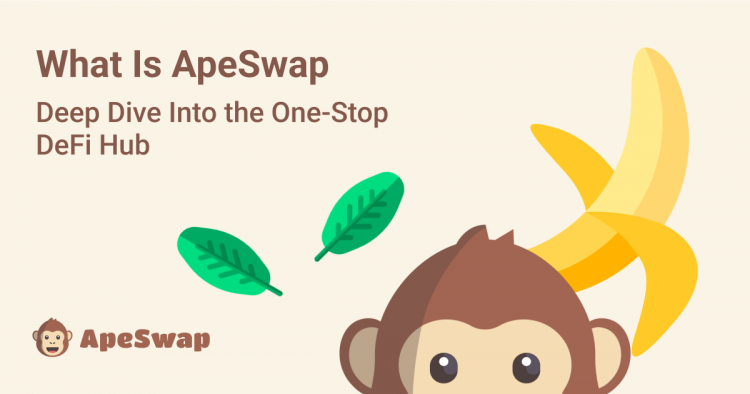The irregularities and lack of trust that characterize centralized exchanges (CEX) have irritated many developers into creating fully decentralized exchanges (DEX) that compete with and establish the true code of decentralization.
One of those decentralized exchanges is ApeSwap. This article will give you a complete guide into what it is, how it works, what it offers, and every other thing you should know. Let’s get started.
Executive Summary
- ApeSwap is a decentralized exchange on BNB Chain.
- ApeSwap provides a full toolkit for DeFi applications, including buying tokens that trade against BANANA, token swaps, offering liquidity, staking, lending and borrowing, IDOs, and margin trading.
- With BANANA and GNANA serving as the two main utility tokens, ApeSwap operates on a dual-token paradigm. GNANA compensates users with access to governance and special perks, while BANANA tokens are used to reward liquidity providers.
- DeFi Yield, Certik, and BSC Gemz have audited ApeSwap in 2021 and 2022, respectively. No serious flaws were discovered.
- To encourage customers to trade their tokens, ApeSwap allows partners to publish tokens on the exchange, set up staking pools, and run yield farms.
What is ApeSwap?
ApeSwap Homepage
ApeSwap is a decentralized exchange (DEX) on the BNB Chain that provides a full toolkit for DeFi applications. This includes access to all sorts of financial services like token swaps, liquidity provision, alternative savings, staking, lending and borrowing, IDOs, tokenized assets, and margin trading.
The decentralized exchange, which has relationships with significant initiatives like KAI, LUNR, FRAX, and Animoca Brands, is regarded as one of the largest in the Binance ecosystem. Through transparency, security, and assistance, ApeSwap sees its goal as giving the crypto masses affordable financial alternatives.
Why was ApeSwap created?
The trendiest trend right now in the crypto industry is DeFi. The ApeSwap platform focuses heavily on decentralizing every facet of the conventional financial sector and opening up access to services like loans, insurance, and others to all members of society, especially those at the bottom and in less developed nations that have not always had easy access to these services.
ApeSwap’s goal is to establish a sustainable, neighborhood-driven decentralized autonomous organization (DAO) that aims to decentralize conventional finance and establish a just economy.
ApeSwap is trying to address issues faced by its centralized competitors, such as the risk of hacking, mismanagement, and arbitrary fees, and to take the place of centralized intermediaries in financial applications such as derivatives, insurance, and loans.
With more than 1.7 billion individuals unbanked individuals globally, it has been impossible for them to access essential financial services that may give them more power. ApeSwap thrives in this space by employing blockchain protocols and cryptocurrency tokens to decentralize all financial services.
The huge chances to gain from what was previously impossible have contributed to the ApeSwap’s protocol increasing appeal among the general public.
Who Founded Apesawap?
A group of people deeply experienced in cryptocurrency trading, farming, and working with other crypto initiatives formed ApeSwap.
They believed they could unite after taking part in the DeFi ecosystem for a while to introduce a more equitable, open, and community-driven decentralized exchange. The initiative was given the hasty name “ApeSwap “— created by DeFi apes for DeFi apes.
Over 15 team members make up ApeSwap, established in 2021. The entire team remains anonymous and is presented behind avatars like Donkey Kong or Harambe. The complete list of co-founders includes:
- ApeGuru — highly experienced full stack developer.
- ApeTastic — highly experienced smart contract developer.
- Harambe Nakamoto — expert on tokenomics, analytics, and engineering
- DK — business development and marketing guru
- Obie Dobo — expert community manager (King of the community jungle)
On the ApeSwap team document, all profiles are pretty extensive, even though they are all anonymous. The entire crew has been working on the project for about a year, which largely reduces the chances of ApeSwap being a scam.
What Makes ApeSwap Unique?
ApeSwap Services
A decentralized exchange, which enables users to trade between more than 150 tokens on BNB and Polygon, is the main offering of ApeSwap, which also provides the standard toolkit for DeFi applications. On token swaps, ApeSwap charges trading fees of 0.2%. A portion of the fees goes to the ApeSwap Treasury, while the rest is distributed to liquidity providers. ApeSwap also introduced leverage trading in Q1 of 2022.
Another important aspect of ApeSwap is its yield farms, encouraging users to contribute liquidity by staking APE-LP tokens. Its auto-compounding vaults, where tokens are automatically staked to produce farming yields, are available to anyone searching for a passive investment approach. BANANA tokens are also burned and repurchased by Burning Vaults, with profits from farming activities on the platform.
Initial Ape Offerings (IAOs) are IDOs at ApeSwap that can either be official IAOs (approved and certified by ApeSwap ) or self-serve IAOs (unapproved projects).
Additionally, 1,000 “non-fungible apes” were made available by ApeSwap for trading at its NFA Auction House. The exchange also intends to work with its partner, Liquid Collectibles, to produce a collection of “non-fungible bananas.”
What is ApeSwap (BANANA) Token?
The main native utility token in the ApeSwap ecosystem is called BANANA. The protocol uses BANANA to do a number of tasks, such as paying users for bringing liquidity to the ApeSwap platform and encouraging markets on the ApeSwap Lending Network.
On the Swap tab of the Exchange (of choice) page, users can buy BANANA using BNB Chain, Polygon, or Ethereum tokens.
Every Thursday, ApeSwap burns BANANA tokens to remove them from circulation and ease inflationary pressure in order to manage return-on-emissions for the protocol.
On the Exchange page’s Liquidity tab, users can provide liquidity to the ApeSwap DEX and then stake their liquidity provider (LP) tokens in any available Yield Farms or BANANA Maximizers to earn BANANA. Or, they can lend or borrow crypto assets on ApeSwap’s lending network to receive BANANA rewards.
What Can I Do With BANANA?
BANANA can be employed in the ways listed below:
- To earn more BANANA or tokens from partner projects, stake your BANANA tokens in ApeSwap’s staking pools.
- To acquire GNANA on the Golden BANANA page
- To create liquidity provider tokens (APE-LP tokens) on the Exchange page by combining BANANA with BNB or BUSD. These tokens earn trading fees and can be placed in yield farms or BANANA maximizers to generate passive revenue.
- To earn BANANA by purchasing Treasury Bills with APE-LP tokens during a predetermined vesting time.
- To earn interest by lending BANANA through the lending network.
- To get liquidity without selling BANANA, borrow against your BANANA on the lending network.
BANANA Tokenomics – Hard Cap
Voters in ApeSwap DAO accepted Governance Proposal 22 to impose a hard cap of 420,000,000 BANANA on August 31, 2022. This indicates that there will never be more BANANA tokens produced (i.e. the sum of all BANANA in circulation, including those burned).
How Many ApeSwap (BANANA) Tokens are in Circulation?
With BANANA and GNANA serving as the two main utility tokens, ApeSwap operates on a dual-token paradigm. GNANA compensates users with access to governance and special perks, while BANANA tokens are used to reward liquidity providers. Four major use cases have been pre-established for the BANANA token:
- Staking it to earn more BANANA.
- Buying GNANA with it.
- Lending BANANA on the lending platform for rewards.
- Swapping it for other tokens.
Additionally, you should know that BANANA has an unlimited total supply and is an inflationary coin. As it stands, 316,800 bananas are released per day and distributed as follows:
- Yield Farms (BNB Chain): 39.5%
- BANANA Pool: 22.7%
- Lending Network (Ola): 9.09%
- Yield Farms (Polygon): 9.09%
- Bonds: 9.09%
- Dev Wallet: 6.36%
- Burned: 2.73%
- $GNANA Pool: 1.36%
BANANA as a Deflationary Token:
Eventually, BANANA will turn into a deflationary token. As a result, ApeSwap has put into place several deflationary mechanics:
- Quarterly buyback and burn: 50% of trade commissions go toward BANANA buybacks and burns.
- Weekly Thursday burns
- IDO-generated GNANA is used to purchase back and burn BANANA.
- Projects partnering with ApeSwap burning BANANA
- Burning Vaults uses 10% of the fees it receives to purchase stablecoins and store them permanently in vaults. These vaults’ rewards are used to purchase and burn $BANANA.
What Gives ApeSwap (BANANA) Value?
ApeSwap (BANANA) gets its value from its utility. Being a governance token, the more people hold, buy, and swap BANANA, the more value is ascribed to the ApeSwap platform. The range of swap options also available with the BANANA token makes it easier to generate liquidity. In simple terms, the more BANANA finds utility, the higher its value. Therefore, its current value is a reflection of its current utility status.
How Does ApewSwap Work?
ApeSwap Staking
Users can purchase BANANA and GNANA tokens by linking their crypto wallet to the exchange and exchanging another token. Additionally, ApeSwap provides token swaps between different tokens and has generated more than $16 billion in total transaction volume and more than $200 million in TVL.
Users can add liquidity to a liquidity pair on the exchange by connecting their wallets to the ApeSwap DEX. In exchange, users get LP tokens, which they can stake to get a piece of the BANANA emissions as a reward.
Additionally, users can stake their BANANA in the ApeSwap burning vaults to increase their portion of the available BANANA supply. ApeSwap currently offers 69% APY on staked BANANA and 87% APY on the liquidity pair of BANANA-BUSD.
Users can farm yield on a wide range of trading pairs. Special farm multipliers on its BANANA farms control the dispersed emitted banana to the farms. Users are encouraged to add more liquidity to these pairs by farms with higher multipliers since they offer bigger BANANA incentives.
Users can share in the trading commissions and BANANA rewards by staking their LP tokens in yield farms. By paying out their tokens, Jungle Farms also enables partner projects to encourage their liquidity. Farmers who provide the highest yields earn the partner token rather than BANANA.
Through ApeSwap, users and protocols can also raise money. Treasury Bills and Initial Ape Offerings (IAOs) are two of the fundraising options provided by ApeSwap.
Initial Ape Offerings (IAO)
ApeSwap Initial Ape Offering (IAO)
Users can participate in new and upcoming projects through Initial Ape Offerings. Initial Ape Offerings (IAO), as the name suggests, are fundraising activities that ApeSwap users can participate in to launch new tokens and increase their liquidity.
IAOs come in two varieties: official and self-serve. ApeSwap audits projects in official IAOs from a list of official IAO partner applicants, gives them marketing assistance, and grants them access to the raised BNB. Participants can pay with BNB or GNANA, which uses the GNANA token’s greater purchasing power to reward its holders.
With Self-serve IAOs, cryptocurrency projects can launch their crowdfunding campaign and generate their own ApeSwap DEX liquidity. However, neither ApeSwap nor the platform provides marketing assistance to these IAOs.
Treasury Bills
ApeSwap Treasury Bills
Registered as the first yield-generating NFT product on the exchange, Treasury Bills are a new endeavor to safeguard ApeSwap’s long-term viability. In exchange for providing liquidity, users can get BANANA Bills or Jungle Bills. As Olympus DAO provides liquidity through its bonds, so does this to create protocol-owned liquidity for ApeSwap.
While Jungle Bills create partner tokens and give these protocols access to their protocol-owned liquidity, BANANA bills provide BANANA tokens at a discount.
The ApeSwap Lending Network allows users to lend and borrow money. Investors can benefit from the value of their assets while still maintaining ownership by borrowing. A token’s collateral factor determines the amount that can be borrowed. As an illustration, WBTC has a 70% collateral component, which allows users to borrow up to 70% of the value of their WBTC. Users who lend money will get a distribution APY in BANANA tokens and a supply APY in the currency they invested (WBTC if they lend WBTC).
What Does ApeSwap Offer?
DeFi Lending and Borrowing
On their platform, ApeSwap offers users a variety of options to invest, profit from taking part in several activities. Most of these activities center on rewarding users in BANANA, the native cryptocurrency that serves as ApeSwap’s utility token and is used to reward users.
Through the ApeSwap platform, any investor can purchase the native BANANA token in addition to lending and borrowing a variety of other cryptocurrencies, like DAI, ETH, USDC, ZRX, USDT, WBTC, BAT, REP, and SAI.
DeFi lending is one area that has attracted customers’ attention. Therefore, ApeSwap has developed solutions that provide loans to interested people or enterprises without intermediaries.
The protocol facilitates lending and borrowing of cryptocurrency assets and allows all parties involved to get interest for committing cryptocurrency. As investors no longer have to spend time, effort, and money interacting with conventional financial industry intermediaries, such services have grown increasingly crucial.
DeFi Rewards and Earning
One area that has substantially enhanced the lives of many investors is the provision of possible rewards. This keeps luring individuals to the DeFi industry and accelerates the uptake of DeFi technologies.
For investors, ApeSwap protocol provides a variety of ways to make money and receive rewards on the platform, including staking and locking tokens in its liquidity pool. Yield farming is a profitable activity in which participants deposit cryptocurrency into the ApeSwap liquidity pool for a predetermined amount of time in exchange for rewards.
Investors can stake any asset they own to any preferred liquidity pool for rewards by using ApeSwap’s native token (BANANA).
Investors once had to go through many processes to accomplish this, but thanks to ApeSwap, it is now a straightforward task. One only needs to convert their cryptocurrency into the BANANA token, after which they can stake it wherever they like or purchase BANANA on the project’s official website.
The ApeSwap platform also advises users on where to stake for the best returns and other top investing opportunities. Such recommendations are fairly accurate because they are data-driven and employ sophisticated algorithms.
DeFi Insurance
The interest rates generated via staking and yield farming far exceed those provided by organizations like banks. However, there is a substantial risk associated with large returns. Because of this, the ApeSwap platform aids customers in hedging against potential risks associated with smart contracts. Along with safeguarding against hackers and bug exploitation, ApeSwap safeguards investors’ assets from depreciating when farmed or staking.
ApeSwap Unique Features
Partnerships
The “most connected and most supporting DEX in crypto” is how ApeSwap describes itself. Its 200+ partners are spread throughout a variety of blockchain-related industries, including NFT, GameFi, DeFi, bridge, launchpads, incubators, and more. In its ApeSwap Jungle, ApeSwap includes a list of its partners. ApeSwap is able to offer marketing as a service to other protocols due to its position as a DeFi hub with all the required solutions for users.
A Variety of Use Cases
ApeSwap includes all the typical features of a decentralized exchange, including token swaps, lending and borrowing, yield farming, staking, and more. But it goes further than that, offering valuable services to investors and protocols.
Its Treasury Bills, for instance, enable ApeSwap and other protocols to produce protocol-owned liquidity. Another illustration would be its Initial Ape Offerings, which serve as a launchpad. In addition to giving protocols a mechanism to kickstart liquidity and take advantage of ApeSwap’s marketing skills, they also allow users to invest in potential new protocols.
Community
ApeSwap is run as a DAO and makes an effort to be open about how it generates and uses money. ApeSwap reserves governance for its most important long-term community members—GNANA holders. It also exposes protocol revenue and burn mechanics on its Financials page.
ApeSwap Governance
Getting Started with ApeSwap
Beginning your journey with ApeSwap is as simple as:
- Participating by engaging with the community, utilizing the DeFi platform, and purchasing the BANANA and GNANA native utility tokens.
- Utilizing the DEX to trade between various cryptocurrency tokens on BNB Chain, Polygon, and Ethereum.
- Creating liquidity between cryptocurrency token pairs that reward liquidity provider (LP) tokens, which can then be staked in yield farms or maximizers to generate BANANA. These tokens can also be used to earn trading fees.
- Earning tokens from related projects, staking BANANA or GNANA in staking pools.
- Utilizing the ApeSwap Lending Network to lend and borrow cryptocurrency assets.
- Taking part in initial ape offerings for brand-new cryptocurrency projects.
- Buying Treasury Bills with LPs to get cheap BANANA or partner tokens that vest over time.
ApeSwap also allows partner crypto projects to. :
- Advertise their cryptocurrency on the decentralized exchange.
- Get advice from the team.
- Interact with the thriving partnership environment.
- Co-market with the team to attract new customers.
- Offer Yield Farms that encourage users to increase the liquidity of their tokens on the exchange.
- Utilize Initial Ape Offerings and Jungle to raise money.
Conclusion
The blockchain sector and the global market at large have benefited from DeFi. ApeSwap provides decentralized financial instruments that guarantee simple transactions and maximize investors’ returns in addition to acting as a decentralized store of value.
Unlike other platforms, ApeSwap is simple to use and comprehend. Due to the platform’s use of BNB Chain and its low switching fees, swapping and staking are even more convenient and advantageous.
In other words, ApeSwap is pushing innovation to develop novel and effective user engagement strategies. The platform is increasingly emerging as the ideal option for investors wishing to optimize their investments.
Source by coinstats.app











